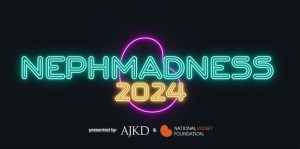Submit your picks! | NephMadness 2024 | #NephMadness
Kelly Hyndman @DrKeeksPhD
Kelly Hyndman is an Associate Professor of Medicine in the Section of Cardio-Renal Physiology and Medicine, Division of Nephrology, at the University of Alabama at Birmingham. She has trained both in comparative physiology and kidney physiology labs and is currently a principal investigator of a basic science lab with research interests in novel mechanisms of fluid-electrolyte balance.
Competitors for the Animal House Region
Team 1: Gila Monster vs Team 2: Mourning Dove
Image generated by Evan Zeitler using Image Creator from Microsoft Designer, accessed via https://www.bing.com/images/create, January, 2024. After using the tool to generate the image, Zeitler and the NephMadness Executive Team reviewed and take full responsibility for the final graphic image.
” data-medium-file=”https://renal.platohealth.ai/wp-content/uploads/2024/03/nephmadness-2024-they-may-look-cute-but-are-all-animals-sweet-5.jpg” data-large-file=”https://renal.platohealth.ai/wp-content/uploads/2024/03/nephmadness-2024-they-may-look-cute-but-are-all-animals-sweet-1.jpg” class=”wp-image-42745 ” src=”https://renal.platohealth.ai/wp-content/uploads/2024/03/nephmadness-2024-they-may-look-cute-but-are-all-animals-sweet-1.jpg” alt width=”481″ height=”481″ srcset=”https://renal.platohealth.ai/wp-content/uploads/2024/03/nephmadness-2024-they-may-look-cute-but-are-all-animals-sweet-1.jpg 844w, https://renal.platohealth.ai/wp-content/uploads/2024/03/nephmadness-2024-they-may-look-cute-but-are-all-animals-sweet-5.jpg 300w, https://renal.platohealth.ai/wp-content/uploads/2024/03/nephmadness-2024-they-may-look-cute-but-are-all-animals-sweet-6.jpg 150w, https://renal.platohealth.ai/wp-content/uploads/2024/03/nephmadness-2024-they-may-look-cute-but-are-all-animals-sweet-7.jpg 768w, https://renal.platohealth.ai/wp-content/uploads/2024/03/nephmadness-2024-they-may-look-cute-but-are-all-animals-sweet-8.jpg 800w, https://renal.platohealth.ai/wp-content/uploads/2024/03/nephmadness-2024-they-may-look-cute-but-are-all-animals-sweet-9.jpg 600w, https://renal.platohealth.ai/wp-content/uploads/2024/03/nephmadness-2024-they-may-look-cute-but-are-all-animals-sweet-10.jpg 400w, https://ajkdblog.org/wp-content/uploads/2024/03/NM24-Animal-House-Commentary-200×200.jpg?crop=1 200w” sizes=”(max-width: 481px) 100vw, 481px”>
Image generated by Evan Zeitler using Image Creator from Microsoft Designer, accessed via https://www.bing.com/images/create, January, 2024. After using the tool to generate the image, Zeitler and the NephMadness Executive Team reviewed and take full responsibility for the final graphic image.
In past NephMadness Animal Houses (2022, 2021, 2018) we have focused on ways animals can survive at the extremes; the estivating lungfish in its mucous cocoon that becomes anuric; the seahorse that lacks glomeruli but yet still makes urine; the shark whose blood is pee. Animals have evolved interesting ways to thrive in harsh environments. Remember the whale who has a reniculated kidney to help keep as much free water as possible even though they are surrounded by seawater and dive to great depths. Studying animals and their unique adaptations is the foundation of our understanding of physiology and this includes kidney physiology. In Animal House 2024 we learned about another exciting avenue of research – the medical potential of venom.
Venom is a poisonous substance secreted by animals and typically injected into the body. When you hear venom, you probably envision snakes with their mouths wide open and fangs ready to bite, or a scorpion with its stinger loaded to strike. But animals that can inject poison are populous with about 15% of the Animal Kingdom being venomous and these animals live in all environments: marine, desert, and likely your backyard. Some appear cute and friendly, like the blue-ring octopuses (there are 4 species) that live in warm seawater from Japan to Australia. These small, 5-8 inch cephalopods with their beautiful colors are one of the most dangerous animals because their venom contains tetrodotoxin; a neurotoxin that blocks voltage-gated sodium channels necessary for action potentials. Recently a Tiktok went viral when a vacationer posted a video of her holding a blue ringed octopus not realizing that this beautiful little creature could kill 26 humans and there isn’t an anti-venom available to treat bites.
Venom is a complex solution that can contain hundreds of metabolites, proteins, lipids to name a few. Interest in venom goes back eons – there are mentions of arrows dipped in venom used in wars but yet snake venom was used to treat ailments in the 7th century BCE medicine practiced. Production of anti-venoms to treat pets and people who are afflicted with venomous bites and stings has been around since the 1940s. But in the 1950s and 60s labs started using venom in experiments and isolating compounds that had interesting effects. A classic example is the venom of the Bothrops Jararaca, a pit viper endemic to South America. Dr. Sergio Henrique Ferreira was a Brazilian physician pharmacologist who, as a postdoctoral fellow, determined there was a bradykinin-potentiating factor in this venom. This report and others ultimately resulted in the development of Captopril, the first angiotensin-converting enzyme inhibitor to treat hypertension in 1975, and it was FDA approved on April 6, 1981. Since this discovery and drug development success story, 10 more venom-derived pharmaceuticals have been approved (see them in this Frontiers in Pharmacology article, table 1 ). The one we want to dive into is exendin-4 from the Gila monster of this year’s Animal House.
Gila monsters (Heloderma suspectum ) are venomous lizards that are native to the southwestern USA and parts of Mexico. They are desert dwelling, so much like the hopping mouse from Animal House 2021, they try to stay out of the sun living in burrows, and to conserve water. One unique physiological phenomenon in the Gila monster, is that its bladder acts as a reservoir for water, and so if dehydrated, water can be reabsorbed from the bladder!
Copyright: Erin Donalson / Shutterstock
” data-medium-file=”https://renal.platohealth.ai/wp-content/uploads/2024/03/nephmadness-2024-they-may-look-cute-but-are-all-animals-sweet-11.jpg” data-large-file=”https://renal.platohealth.ai/wp-content/uploads/2024/03/nephmadness-2024-they-may-look-cute-but-are-all-animals-sweet-12.jpg” class=” wp-image-41466″ src=”https://renal.platohealth.ai/wp-content/uploads/2024/03/nephmadness-2024-they-may-look-cute-but-are-all-animals-sweet-2.jpg” alt width=”392″ height=”261″ srcset=”https://renal.platohealth.ai/wp-content/uploads/2024/03/nephmadness-2024-they-may-look-cute-but-are-all-animals-sweet-2.jpg 4571w, https://renal.platohealth.ai/wp-content/uploads/2024/03/nephmadness-2024-they-may-look-cute-but-are-all-animals-sweet-11.jpg 300w, https://renal.platohealth.ai/wp-content/uploads/2024/03/nephmadness-2024-they-may-look-cute-but-are-all-animals-sweet-12.jpg 1024w, https://renal.platohealth.ai/wp-content/uploads/2024/03/nephmadness-2024-they-may-look-cute-but-are-all-animals-sweet-13.jpg 150w, https://renal.platohealth.ai/wp-content/uploads/2024/03/nephmadness-2024-they-may-look-cute-but-are-all-animals-sweet-14.jpg 768w, https://renal.platohealth.ai/wp-content/uploads/2024/03/nephmadness-2024-they-may-look-cute-but-are-all-animals-sweet-15.jpg 1536w, https://renal.platohealth.ai/wp-content/uploads/2024/03/nephmadness-2024-they-may-look-cute-but-are-all-animals-sweet-16.jpg 2048w, https://ajkdblog.org/wp-content/uploads/2024/01/NM24-Animal-House-Gila-Monster-1200×800.jpg 1200w” sizes=”(max-width: 392px) 100vw, 392px”>
Copyright: Erin Donalson / Shutterstock
They release their venom via their teeth. They have little grooves in their teeth that pick-up venom from glands in their lower jaw, and as they chew on their prey/victim the venom is injected with every bite. According to National Geographic, from 2000-2011, 105 humans were bitten by Gila monsters, and luckily no deaths were reported. However, just recently in 2024, a man was bitten by one of his pet Gila monsters, and unfortunately passed away. Gila venom can cause pain, vomiting, rapid heartbeat, and low blood pressure, but there is something else that is in this venom that is revolutionizing human health- exendin-4.
Gila monsters only eat 5-10 times a year and they experience postprandial increases in plasma exendin-4. It turns out exendin-4 shares a high degree of amino acid identity with human glucagon-like peptide-1 (GLP-1) and it can bind to the GLP-1 receptors in mammals. GLP-1 was discovered by Dr. Svetlana Mojsov, a female Serbian chemist working at the Massachusetts General Hospital. She and colleagues purified and identified GLP-1 and determined that it was a potent stimulator of insulin release. Interesting side story: just prior to her arrival at the Mass General, Dr. Joel Habener had cloned (from the angler fish none-the-less), the gene that encodes the hormone, glucagon (involved in gluconeogenesis). There is a lot of controversy here related to recognition of efforts that I won’t expand on, but if you are interested, here is a new commentary. Back to GLP-1 and our sweet Gila monster.
GLP-1 receptor activation has a number of health benefits other than helping with glycemic control: it slows gut motility leading to a feeling of fullness (helps with weight loss) and may promote neuroprotection or neurogenesis. Why the discovery of the Gila monster exendin-4 was important is that the GLP-1 half-life is very short (minutes) but the half-life of exendin-4 is hours, thus it led to the development of the GLP-1 receptor agonist, semaglutide, now FDA approved to treat diabetes (2017) and obesity (2021). Much like the story of the development of captopril, it was isolating and understanding the functions of a single molecule in the Gila monster venom that has helped many patients manage their blood glucose and weight. It is estimated that < 0.01% of venoms and their constituents have been discovered and in this era of ‘omics it’s no surprise that venomics is at the forefront of innovation to find other compounds to help improve the health of humans.
Our second animal this year is the mourning dove who is representing the birds! Birds are flying dinosaurs, and they are the only animals beside mammals that have a loop of Henle. This means they can concentrate the urine to an osmolality greater than plasma. The Gila monster can’t do that! Birds may hold the answer as to why uncontrolled glucose is so bad for us because birds live in a hyperglycemic state. Their blood glucose is 1.5-2 times higher than mammals of a similar size (~300 mg/dL, but HbA1c = 0.73-3.7%). If you have a favorite bird and are curious about their blood glucose, check out Table 1 from Dr. Sweazea’s recent review article. She and colleagues have been determining why birds don’t have the same adverse events associated with a chronically high circulating glucose. We know in mammals that high circulating glucose is an indicator of diabetes mellitus, and diabetes is a systemic disease with many pathological outcomes including leading to diabetic kidney disease (DKD). It can cause metabolic derangements not only in glucose but also lipids leading to oxidative stress and injury to many organs and tissues in the body. Yet, birds don’t suffer these same consequences. As 99.5% of birds fly (there are 60 species alive today that are flightless out of 11,000 species), part of the hypothesis is that birds need this glucose to support the energetic cost of flight. Indeed birds have higher metabolic rates and higher lifetime energy expenditures than mammals, but yet they do not produce many reactive oxygen species. They also don’t develop many advanced glycation end products (AGE) thus they don’t activate the receptor for AGE (RAGE). To learn more about the AGE-RAGE pathways here is a review related to Type I Diabetes.
How do birds have high blood glucose? Birds have glucose transporters, GLUTs, but likely lack a functional GLUT4 which is the insulin-responsive GLUT that promotes a post-meal glucose uptake in the muscles and fat of mammals. In birds, it may be GLUT1 and GLUT12 that are insulin-sensitive, and during rest bird blood glucose can drop, but remains at a level higher than expected. Glucose tolerance tests have been performed in ostriches for example, and indeed they clear a glucose load within 2 hours (just like in humans) even though glucose levels at baseline are higher. This suggests it’s not that birds can’t handle glucose; it is that they have a higher set point.
Birds aren’t the only animals that fly and have high blood glucose – so do nectar drinking bats. These flying mammals spend 12 hours a night foraging for nectar and usually hover as they feed. Although at rest they have a blood glucose of 54 mg/dL, while ingesting nectar it can rapidly rise to 540 mg/dL. The measured HbA1c is only 3.9% suggesting that these glucose spikes are very temporary. They also appear to be protected from the adverse events associated with high blood glucose, but more bat research is needed to see if they share common mechanisms with the birds.
Animal House 2024 has again highlighted how studying a variety of organisms not only helps us understand physiological processes but also may provide clues to the pathogenesis of disease. In the case of the Gila monster and mourning dove, there may be many novel therapeutic targets or even therapies hidden in these organisms. The Gila monster venom leading to drug development that is improving human health so much that even Walmart is reporting that food sales are down. The Gila monster should be crowned the winner of the 2024 NephMadness. However, don’t discount birds (the underBird in this competition) who may hold yet-to-be discovered mechanisms on how to prevent hyperglycemic end organ damage. Finally, remember just because that creature in the wild is brightly colored and may appear docile doesn’t necessarily mean it is sweet (both figuratively or actually).
– Guest Post written by Kelly Hyndman @DrKeeksPhD
As with all content on the AJKD Blog, the opinions expressed are those of the author of each post and are not necessarily shared or endorsed by the AJKD Blog, AJKD, the National Kidney Foundation, Elsevier, or any other entity unless explicitly stated.
Click to read the Animal House Region
Submit your picks! | #NephMadness | @NephMadness
- The Renal Warrior Project. Join Now
- Source: https://ajkdblog.org/2024/03/05/nephmadness-2024-they-may-look-cute-but-are-all-animals-sweet/

